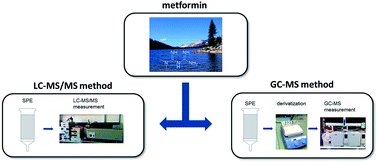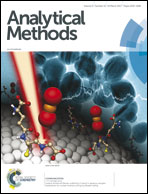A novel GC-MS method for the determination and quantification of metformin in surface water
Abstract
Drug therapy for diabetes mellitus has increased significantly in recent years. 1,1-Dimethylbiguanide hydrochloride (metformin) is the most common drug used for the treatment of diabetes. Metformin is not metabolized in the human body and enters the water cycle via sewage. A new gas chromatography-mass spectrometry (GC-MS) method has been developed which enables the quantification of metformin in surface water samples even at low concentrations in the ng L−1 range. A solid phase extraction (SPE) method for the preconcentration of metformin and the internal standard 1-butylbiguanide (buformin) was established, and the method parameters such as the composition and volume of the eluent were optimized. Derivatization of metformin and buformin was obtained by using n-methyl-bis (trifluoroacetamide) (MBTFA). The reaction conditions of the derivatization, such as the reaction temperature and volume of the derivatization agent, were evaluated. The limit of detection (LOD) and limit of quantification (LOQ) were determined to be 3.9 ng L−1 and 12 ng L−1 in surface water samples. Linearity was shown over a concentration range of 10–50 ng L−1. The good performance of the method was demonstrated by comparison with a liquid chromatography tandem mass spectrometry (LC-MS/MS) method. The results indicate that the GC-MS method is a reliable and sensitive alternative for the quantification of metformin in surface water.



 Please wait while we load your content...
Please wait while we load your content...